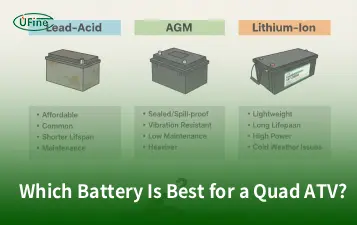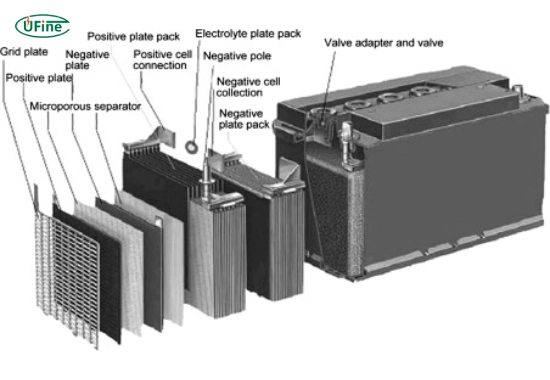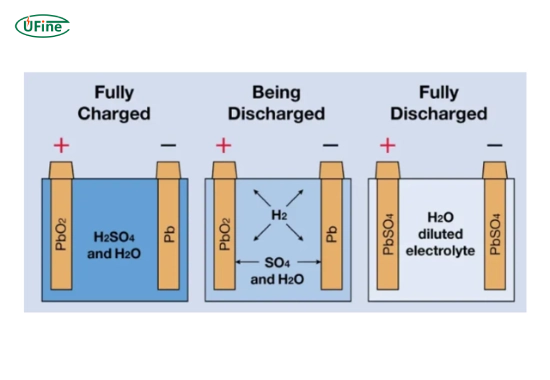
- Part 1. What is a glass mat battery?
- Part 2. How does a glass mat battery work?
- Part 3. Key components of a glass mat battery
- Part 4. What are the main benefits of a glass mat battery?
- Part 5. Common applications of glass mat batteries
- Part 6. Limitations of glass mat batteries
- Part 7. Comparing glass mat batteries to other battery types
- Part 8. How to maintain a glass mat battery?
- Part 9. How long do glass mat batteries last?
- Part 10. How to choose the right glass mat battery?
- Part 11. FAQs about glass mat batteries
Glass mat batteries are gaining popularity for a range of applications, including cars and RVs, solar systems, and backup power sources. But what exactly are they, and how do they work? In this comprehensive guide, we will delve into the technology behind glass mat batteries, their advantages, and the key considerations to keep in mind before making a decision.
Let’s explore the world of glass mat battery systems and help you determine whether they’re the right choice for your needs.
Part 1. What is a glass mat battery?
A glass mat battery, also known as an Absorbent Glass Mat (AGM) battery, is a type of lead-acid battery that uses a fiberglass mat to absorb the battery acid. This design keeps the acid in place, allowing the battery to be spill-proof, maintenance-free, and more efficient than traditional flooded batteries.
What makes glass mat batteries different from regular lead-acid batteries?
The main difference lies in the internal structure. Instead of having liquid acid sloshing around, the acid in AGM batteries is absorbed into the fine glass mat separators. This makes the battery seal vibration-resistant and safer in many environments.
Part 2. How does a glass mat battery work?
Here’s a quick answer:
A glass mat battery utilizes fiberglass mats to maintain the electrolyte between the battery’s plates, enabling faster reactions, lower resistance, and improved power delivery.
In more detail, here’s how it works:
- Electrolytes are absorbed by ultra-thin fiberglass mats placed between lead plates.
- This creates close contact between the acid and the plates, increasing efficiency.
- The design reduces internal resistance, enabling the battery to discharge and recharge more quickly.
- Because the electrolyte is immobilized, the battery is leak-proof and can work in different orientations.
Part 3. Key components of a glass mat battery
To understand the full technology, let’s break down the internal components:
- Positive and negative lead plates: These plates store and release electrical energy during charge and discharge cycles.
- Absorbent glass mat separator: A fiberglass sheet that holds the electrolyte in place.
- Electrolyte (battery acid): Provided in sulfuric acid, absorbed into the mat.
- Sealed casing: Fully enclosed, with a valve-regulated design to manage gas escape.
This structure is what gives AGM batteries their unique performance characteristics.
Part 4. What are the main benefits of a glass mat battery?
Why choose a glass mat battery over traditional batteries?
Here are the top advantages of using a glass mat battery:
- Maintenance-free: No need to top off water or check acid levels.
- Spill-proof and leak-proof: Thanks to the sealed design and absorbed electrolyte.
- Longer lifespan: Lasts longer than many traditional lead-acid batteries.
- Faster charging: Lower internal resistance leads to quicker charge times.
- Deep cycle capable: Ideal for solar, RV, and marine use where deep discharges are common.
- Vibration-resistant: Perfect for off-road or mobile applications.
- Lower self-discharge rate: Keeps charge longer when not in use.
All these features make AGM batteries a great all-around solution for many energy storage needs.
Part 5. Common applications of glass mat batteries
Where are glass mat batteries used?
Glass mat batteries are versatile and can be used in the following ways:
- Automotive start-stop systems
- Recreational vehicles (RVs)
- Solar power storage
- Off-grid homes
- Marine and boating systems
- Backup power (UPS systems)
- Motorcycles and ATVs
Their durability and reliability make them a favorite in demanding environments.
Part 6. Limitations of glass mat batteries
While AGM batteries have many benefits, they’re not perfect.
What are the downsides of glass mat batteries?
- Higher upfront cost: More expensive than traditional flooded batteries.
- Sensitive to overcharging: Needs a proper charge controller.
- Not ideal for extreme heat: High temperatures can shorten lifespan.
- Heavyweight: Still heavier than lithium batteries.
A different battery type may be more suitable if you require a lightweight or high-temperature solution.
Part 7. Comparing glass mat batteries to other battery types
When choosing the correct battery for your system, it is essential to understand the differences between various battery technologies. Glass mat batteries, also known as AGM batteries, are just one option among many. Others include flooded lead-acid, gel, and lithium-ion batteries. Each type has pros and cons regarding cost, lifespan, maintenance, performance, and safety.
Key differences explained:
- Flooded lead-acid batteries are the most affordable option. Still, they require regular maintenance, including topping off water and cleaning terminals. They are also prone to leaking and off-gassing, which makes them less safe in enclosed spaces.
- AGM (Absorbent Glass Mat) batteries improve on traditional lead-acid batteries by being sealed and maintenance-free. They offer better performance, charge faster, and are safer to use in various orientations.
- Gel batteries are also sealed and maintenance-free, but use a gel-like electrolyte. They are more sensitive to charging rates and have lower power output than AGM batteries. However, they perform well in deep-cycle applications.
- Lithium-ion batteries are the most advanced option. They are lightweight, charge extremely fast, and offer a long lifespan. However, they are significantly more expensive and require advanced battery management systems to operate safely.
Battery type comparison table (realistic data)
| Feature | Flooded Lead-Acid | AGM (Glass Mat) | Gel Cell | Lithium-Ion |
|---|---|---|---|---|
| Maintenance | High (add water) | None | None | None |
| Spill-proof | No | Yes | Yes | Yes |
| Orientation flexibility | No | Yes | Yes | Yes |
| Cycle life (deep cycle) | 300–500 cycles | 500–1,000 cycles | 500–1,200 cycles | 2,000–5,000 cycles |
| Self-discharge rate (per month) | ~10% | 1–3% | 1–3% | <1% |
| Charging speed | Slow | Fast | Moderate | Very fast |
| Weight | Heavy | Heavy | Heavy | Lightweight |
| Temperature sensitivity | Moderate | Moderate | Low | High (needs BMS) |
| Cost (per 100Ah unit) | $100–$150 | $180–$250 | $200–$300 | $600–$1,200 |
| Best for | Budget systems, backup | RVs, solar, marine | Deep cycle, medical | EVs, solar, off-grid |
As you can see, AGM batteries offer a solid middle ground, providing better performance and safety than flooded batteries, while also offering a lower cost than lithium. They’re ideal for users who want reliability without the high price tag of lithium systems.
Part 8. How to maintain a glass mat battery?
Although AGM batteries are maintenance-free, you still need to take care of them to extend their lifespan.
Tips for maintaining a glass mat battery:
- Use a smart charger designed for AGM batteries.
- Avoid overcharging — it can cause heat buildup and damage.
- Store in a cool, dry place when not in use.
- Check voltage levels regularly if using the system in deep-cycle applications.
- Do not completely drain the battery unless it is a deep-cycle model.
These simple tips can help you maximize your battery’s lifespan.
Part 9. How long do glass mat batteries last?
On average, glass mat batteries last 3 to 7 years, depending on usage conditions and maintenance.
Factors that affect battery life include:
- Depth of discharge: Deeper discharges reduce lifespan.
- Temperature: High heat or freezing temperatures can shorten life.
- Charging method: Overcharging or undercharging can cause damage.
- Vibration and handling: Constant jarring can wear parts faster.
AGM batteries tend to outlast flooded batteries, making them a better long-term investment in many cases.
Part 10. How to choose the right glass mat battery?
When picking an AGM battery, consider the following:
- Capacity (Ah): How much energy storage do you need?
- Voltage (12V, 24V, etc.): What system are you using it for?
- Size and weight: Will it fit your space and weight limits?
- Brand reputation: Stick with known, reliable manufacturers.
- Warranty: A solid warranty can give peace of mind.
Also, ensure the battery is designed for your specific use case, whether it’s for starting, deep cycling, or dual-purpose applications.
Artikel Terkait: Charging Lithium Ion Batteries: A Complete Guide
Part 11. FAQs about glass mat batteries
What is the main difference between AGM and standard lead-acid batteries?
Unlike standard flooded batteries, AGM batteries use a glass mat separator to absorb the electrolyte, making them sealed, spill-proof, and maintenance-free.
Can you use a regular charger on a glass mat battery?
It is best to use a charger specifically designed for AGM batteries. Regular chargers may overcharge the battery, reducing its lifespan.
Do glass mat batteries need ventilation?
AGM batteries are sealed and do not release harmful gases when used normally, so they do not require special ventilation.
Are AGM and gel batteries the same?
No. While both are sealed and maintenance-free, AGM batteries use fiberglass mats. In contrast, gel batteries use silica to thicken the electrolyte. Their charge and discharge characteristics are also different.
Can glass mat batteries be mounted on their side?
AGM batteries can be mounted in any position since the electrolyte is absorbed and won’t leak.
Related Tags:
More Articles

What Battery Do You Need for a Quad?
Discover the best battery for a quad: voltage, size chart, lifespan, replacement steps, and common issues. Everything ATV riders need to know.
What Does a Battery Kill Switch Do and Should You Install One?
Discover if battery kill switches work, where to install them, and their drawbacks. A simple guide for wiring, safety, and reducing battery drain.
A Complete Guide to the Best Batteries for Flashlights
Discover the best batteries for flashlights: alkaline, lithium, NiMH & rechargeable options. Tips for performance and maintenance.
Graphene Battery vs Lithium Battery: Which is Better?
Compare graphene battery vs lithium battery in energy density, charging speed, lifespan, cost, and EV applications. Learn which battery leads in 2025.
What is the Difference Between MCA and CCA on Batteries?
Learn the difference between MCA and CCA batteries. Understand what MCA means, what CCA is, and how to choose the right battery for vehicles or marine engines.




